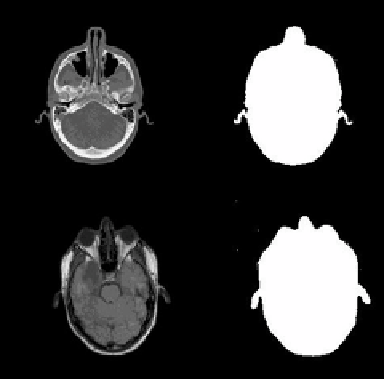Biomedical Engineering Reference
In-Depth Information
its right is picked as the threshold. Adjacency includes the eight directions: N,
S, E, W, NE, NW, SE, and SW.
The region-growing procedure for the background/foreground segmentation
is fully automatic and takes about 2% of the total registration time.
13.2.1.2
Three Binning Techniques
The first binning technique is a binarization approach. All the background voxels
are put into one bin and the remaining voxels (foreground) are put into the other
bin. Lo
et al.
[16] developed this approach. The binarized, 2-bin images, see Fig.
13.3, are down-sampled by a factor of 2 along the
x
,
y
, and
z
axis directions. The
down-sampled images are then used as the input to the first level of the mul-
tiresolution registration. The result of the first level provides the initial estimate
for the second level, where the registration of the original images is performed.
The second binning technique, linear binning, is based on equidistant binning.
All background voxels are put into one bin, then equidistant binning is applied
to the remaining voxels, which assigns them to the rest of the bins. The binned
images are then down-sampled and two-level registration is performed.
The third technique is a nonlinear binning approach [25]. The background of
the image is first segmented into one bin and the remaining voxels are assigned
to the remaining (
k
−
1) bins by
k
-means clustering [23].
Figure 13.3: A CT image (upper) and an MR image (lower) are shown with the
original image on the left and the binarized image on the right.

